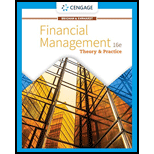
a.
To determine:
Definition of synergy; merger
a.
Explanation of Solution
Synergy is the motivation to merger. It means that after merger companies are able to reduce cost and gain from merger. It results in economies of scale in management, marketing and production and increases efficiency. Merger is bring business of two companies under one business and increasing the value of shares.
b.
To determine:
Definition of horizontal merger, vertical merger, Congeneric merger, conglomerate merger
b.
Explanation of Solution
Horizontal merger means joining business of having same line of business. Vertical merger means joining business with its supplier or customer. Congeneric merger happens between related industries. Conglomerate merger happens when one business decides to enter into another industry and join with company in another industry.
c.
To determine:
Definition of friendly merger, hostile merger, defensive merger, tender offer, Target Company, breakup value, acquiring company
c.
Explanation of Solution
A merger in which merger is approved by both the companies is called friendly merger. A situation where merger offer is resisted by the target company, it is called hostile merger. When one company is acquired by another company but Target Company tries to avoid acquisition by initial acquisition company is defensive merger. A tender offer is a friendly merger where merger takes place with the approval of management of both companies and shareholders tender the shares. Target Company is the firm which is acquired by another company under merger. Breakup value is the value of company which is acquired by another company. Acquiring company is the company which purchase the another company under merger.
d.
To determine:
Definition of operating merger, financial merger
d.
Explanation of Solution
Operating merger is merger in which operations in the firm involved are integrated and generate operating synergy. Financial merger is where operations of two companies are not integrated and does not generate operating synergy.
e.
To determine:
Definition of purchase accounting
e.
Explanation of Solution
Purchase accounting is a method of accounting in which assets and liabilities of the firm are valued at fair price when merger is taking place to record in the books of acquiring company.
f.
To determine:
Definition of white knight, proxy fight
f.
Explanation of Solution
White knight is the situation under merger where friendly investor invests in the company and acquires it with the support of management. The merger takes place at the fair value or fair consideration of assets and liabilities. Proxy fight is situation that arises when shareholders send their representatives as proxy and they form a group and try to win corporate vote.
g.
To determine:
Definition of joint venture, corporate alliance
g.
Explanation of Solution
Joint venture is a creation of new entity by two or more parties to acquire new market, to gain from enhanced operations by acquiring skills and capabilities and sharing the risk of investment. Corporate alliance is a relationship build with the motive to reduce cost and improve efficiency.
h.
To determine:
Definition of divestiture, spin-off
h.
Explanation of Solution
Divestiture means divestment. It means withdrawing or cutting-off the investments done by company into another company. Spin-off of corporate means that company splits its one part business as a separate business.
i.
To determine:
Definition of holding company, operating company, parent company
i.
Explanation of Solution
Holding company is the company which has ownership interest in another company and runs the business of these companies. An operating company is the company which runs operations and provides with goods and services to customers. Parent company is the company which holds sufficient power in another company to influence the operations of the company. Sometimes holding company is also known as parent company.
j.
To determine:
Definition of arbitrage, risk arbitrage
j.
Explanation of Solution
Arbitrage is the advantage of difference in price in the two or more different markets and has no negative cash-flows as commodities are simultaneously bought and sold in two different markets at different prices striking the imbalance. Risk arbitrage means that stocks are purchased of the companies which may become takeover targets in some near future.
Want to see more full solutions like this?
Chapter 22 Solutions
Financial Management: Theory & Practice
- please don't use ai and if you cant understand given values please don't answer question otherwise unhelpful will be given.arrow_forwardfinance subjectarrow_forwardCould you help explain, what is the complete salary survey analysis, and ensuring the data is relevant and up-to-date? What is the job evaluation and compensation plan? How to ensure the final report is comprehensive, clearly structured, and aligned with the company vision?arrow_forward
- The maturity value of an $35,000 non-interest-bearing, simple discount 4%, 120-day note is:arrow_forwardCarl Sonntag wanted to compare what proceeds he would receive with a simple interest note versus a simple discount note. Both had the same terms: $18,905 at 10% for 4 years. Use ordinary interest as needed. Calculate the simple interest note proceeds. Calculate the simple discount note proceeds.arrow_forwardWhat you're solving for Solving for maturity value, discount period, bank discount, and proceeds of a note. What's given in the problem Face value: $55300 Rate of interest: 10% Length of note: 95 days Date of note: August 23rd Date note discounted: September 18th Bank discount rate:9 percentarrow_forward

 Intermediate Financial Management (MindTap Course...FinanceISBN:9781337395083Author:Eugene F. Brigham, Phillip R. DavesPublisher:Cengage Learning
Intermediate Financial Management (MindTap Course...FinanceISBN:9781337395083Author:Eugene F. Brigham, Phillip R. DavesPublisher:Cengage Learning EBK CONTEMPORARY FINANCIAL MANAGEMENTFinanceISBN:9781337514835Author:MOYERPublisher:CENGAGE LEARNING - CONSIGNMENT
EBK CONTEMPORARY FINANCIAL MANAGEMENTFinanceISBN:9781337514835Author:MOYERPublisher:CENGAGE LEARNING - CONSIGNMENT Auditing: A Risk Based-Approach to Conducting a Q...AccountingISBN:9781305080577Author:Karla M Johnstone, Audrey A. Gramling, Larry E. RittenbergPublisher:South-Western College Pub
Auditing: A Risk Based-Approach to Conducting a Q...AccountingISBN:9781305080577Author:Karla M Johnstone, Audrey A. Gramling, Larry E. RittenbergPublisher:South-Western College Pub Auditing: A Risk Based-Approach (MindTap Course L...AccountingISBN:9781337619455Author:Karla M Johnstone, Audrey A. Gramling, Larry E. RittenbergPublisher:Cengage Learning
Auditing: A Risk Based-Approach (MindTap Course L...AccountingISBN:9781337619455Author:Karla M Johnstone, Audrey A. Gramling, Larry E. RittenbergPublisher:Cengage Learning Financial Reporting, Financial Statement Analysis...FinanceISBN:9781285190907Author:James M. Wahlen, Stephen P. Baginski, Mark BradshawPublisher:Cengage Learning
Financial Reporting, Financial Statement Analysis...FinanceISBN:9781285190907Author:James M. Wahlen, Stephen P. Baginski, Mark BradshawPublisher:Cengage Learning





